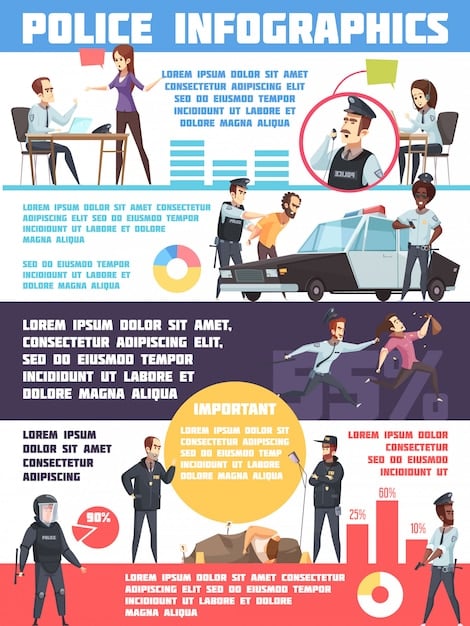How to Advocate for Safer Neighborhoods: Engage with Law Enforcement

Advocating for safer neighborhoods involves proactive engagement with local law enforcement through community meetings, crime reporting, supporting local initiatives, and fostering open communication to address safety concerns effectively.
Want to make your neighborhood a safer place? How to Advocate for Safer Neighborhoods: A Guide to Engaging with Local Law Enforcement is your roadmap to building a stronger, more secure community by working hand-in-hand with the police and other local authorities.
Understanding Your Local Law Enforcement
Before diving into advocacy, it’s crucial to understand the structure and function of your local law enforcement. This knowledge empowers you to engage effectively and strategically.
Structure of Law Enforcement
Law enforcement agencies vary in structure depending on the size and needs of the community they serve. Understanding this structure helps you navigate the system.
- Police Departments: Typically handle law enforcement within city or town limits.
- Sheriff’s Offices: Often cover unincorporated areas and may also manage county jails.
- State Police/Highway Patrol: Enforce state laws and provide assistance on highways.
Knowing which agency has jurisdiction in your neighborhood is the first step in effective communication and advocacy.

Roles and Responsibilities
Each law enforcement agency has specific roles and responsibilities. Identifying these helps you understand their focus and how they can assist with neighborhood safety.
- Patrol: Responding to calls, maintaining a visible presence, and preventing crime.
- Investigations: Investigating crimes, gathering evidence, and apprehending suspects.
- Community Policing: Building relationships with community members, addressing concerns, and problem-solving.
By understanding these roles, you can direct your concerns to the appropriate department or officer.
In summary, understanding the framework of local law enforcement is essential for effective advocacy. This knowledge empowers you to engage strategically and communicate clearly with those responsible for keeping your neighborhood safe. Recognizing the structure and roles of different agencies ensures that your concerns are directed to the right people, facilitating a more effective and collaborative approach to community safety.
Building Relationships with Law Enforcement
Establishing strong relationships with local law enforcement is key to creating safer neighborhoods. These relationships foster trust, communication, and collaboration.
Attend Community Meetings
Community meetings are a great way to meet officers, voice concerns, and learn about crime trends in your area.
- Neighborhood Watch: Participating in Neighborhood Watch programs provides a platform for residents and law enforcement to discuss safety issues.
- Town Halls: Attending town hall meetings allows you to ask questions and hear updates from local officials, including law enforcement.
- Community Advisory Boards: Joining advisory boards gives you a direct voice in shaping law enforcement policies and strategies.
These meetings provide opportunities to build relationships and work together to address safety concerns.
Communicate Openly
Open communication is essential for building trust and addressing concerns effectively.
- Report Suspicious Activity: Promptly report any suspicious activity to the police.
- Share Information: Share relevant information with law enforcement, such as security camera footage or knowledge of criminal activity.
- Maintain Contact: Keep in regular contact with your local officers to build rapport and stay informed.
By communicating openly and consistently, you can help law enforcement do their job more effectively.
Building relationships with law enforcement is pivotal for fostering neighborhood safety. Attending community meetings and communicating openly with officers fosters trust, enables collaboration, and facilitates effective problem-solving. Cultivating these relationships creates a united front against crime, where residents and law enforcement work together to build a safer, more secure community.
Effective Communication Strategies
Communicating effectively with law enforcement ensures that your concerns are heard and addressed appropriately. Clear and concise communication is essential for achieving positive outcomes.
Be Clear and Concise
When communicating with law enforcement, be clear, concise, and specific about your concerns.
- Provide Details: Include as many relevant details as possible, such as dates, times, locations, and descriptions.
- Use Specific Language: Avoid vague or general statements. Use specific language to describe the issue.
- Stay Focused: Stay focused on the issue at hand and avoid getting sidetracked.
Accurate and detailed information helps law enforcement understand the situation and take appropriate action.
Use Proper Channels
Utilize the appropriate channels for communication, depending on the nature of your concern.
- Emergency Calls: Use 911 for emergencies that require immediate response.
- Non-Emergency Lines: Use non-emergency lines for non-urgent issues, such as noise complaints or minor disturbances.
- Email and Online Forms: Use email or online forms for submitting tips, providing feedback, or requesting information.

Using the proper channels ensures that your message reaches the right people and is prioritized appropriately.
Effective communication strategies are essential for fostering collaboration between residents and law enforcement. By communicating clearly, concisely, and through the appropriate channels, residents ensure that their concerns are heard, understood, and acted upon effectively. This leads to more responsive and targeted law enforcement efforts, contributing to a safer and more secure neighborhood for all.
Supporting Local Law Enforcement Initiatives
Supporting local law enforcement initiatives demonstrates your commitment to community safety and strengthens the partnership between residents and police.
Volunteer Opportunities
Volunteering with local law enforcement can provide valuable assistance and support to officers.
- Citizen Patrols: Participating in citizen patrols helps deter crime and provide a visible presence in the community.
- Administrative Support: Providing administrative support, such as answering phones or filing documents, frees up officers to focus on frontline duties.
- Victim Support: Offering support to victims of crime helps them cope with trauma and navigate the criminal justice system.
Volunteering provides a meaningful way to contribute to the safety and well-being of your community.
Fundraising and Donations
Fundraising and donations can provide much-needed resources for law enforcement agencies.
- Equipment and Technology: Donating funds for equipment and technology upgrades helps officers stay up-to-date and effective.
- Training Programs: Supporting training programs ensures that officers have the skills and knowledge they need to perform their duties safely and effectively.
- Community Programs: Funding community programs, such as youth outreach initiatives, helps prevent crime and build positive relationships.
Financial support can significantly enhance the capabilities of local law enforcement.
Supporting local law enforcement initiatives is a tangible way to contribute to the safety and well-being of your community. Volunteering time and providing financial support empowers law enforcement agencies to enhance their capabilities, implement effective community programs, and stay up-to-date with the latest technology and training. By actively participating in these initiatives, residents contribute to a stronger, more resilient community.
Addressing Specific Safety Concerns
Identifying and addressing specific safety concerns in your neighborhood is crucial for creating a safer environment. A proactive approach to problem-solving can lead to lasting positive change.
Identify Problem Areas
Work with your neighbors and local law enforcement to identify areas where crime or safety concerns are prevalent.
- Conduct Surveys: Conduct surveys to gather feedback from residents about their safety concerns.
- Analyze Crime Data: Analyze crime data to identify patterns and trends.
- Walk the Neighborhood: Walk the neighborhood with local officers to identify problem areas and potential solutions.
Identifying problem areas is the first step in developing targeted solutions.
Develop Action Plans
Collaborate with law enforcement and community members to develop action plans for addressing specific safety concerns.
- Increase Lighting: Increase lighting in dark or poorly lit areas to deter crime.
- Improve Security: Improve security measures, such as installing security cameras or reinforcing doors and windows.
- Organize Community Events: Organize community events, such as block parties or clean-up days, to strengthen social connections and build community pride.
Effective action plans require collaboration and a commitment to long-term solutions.
Addressing specific safety concerns requires a collaborative and proactive approach. By actively identifying problem areas and working with law enforcement and community members to develop targeted action plans, residents can create a safer and more secure neighborhood for all. This collaborative problem-solving leads to lasting positive change and empowers communities to take ownership of their safety.
Measuring Success and Sustaining Efforts
Measuring the success of your advocacy efforts and sustaining them over time is essential for long-term impact. Consistent monitoring and adjustments ensure that your efforts remain effective.
Track Crime Statistics
Track crime statistics to measure the impact of your advocacy efforts and identify areas where further improvements are needed.
- Compare Data: Compare crime statistics before and after implementing new initiatives.
- Monitor Trends: Monitor crime trends to identify emerging issues and adjust your strategies accordingly.
- Share Results: Share the results of your analysis with law enforcement and community members to inform decision-making.
Data-driven analysis provides a clear picture of progress and areas for improvement.
Seek Feedback
Seek feedback from law enforcement and community members to evaluate the effectiveness of your advocacy efforts.
- Conduct Surveys: Conduct surveys to gather feedback on specific initiatives or programs.
- Hold Focus Groups: Hold focus groups to gather in-depth insights and perspectives.
- Attend Community Meetings: Attend community meetings to hear feedback and address concerns.
Feedback helps you understand what’s working and what needs to be improved.
Measuring success and sustaining efforts is crucial for the long-term effectiveness of community safety initiatives. Tracking crime statistics and seeking feedback from law enforcement and residents provides valuable insights into what is working and what needs improvement. This data-driven approach ensures that advocacy efforts remain targeted, responsive, and impactful over time, fostering a continuous cycle of improvement and community empowerment.
| Key Point | Brief Description |
|---|---|
| 🤝 Build Relationships | Engage with law enforcement at community meetings. |
| 🚨 Report Concerns | Communicate clearly and use the right channels. |
| 💪 Support Initiatives | Volunteer and donate to local law enforcement. |
| 📊 Track Progress | Monitor crime statistics and seek feedback. |
FAQ
▼
Check your local government’s website or contact your police department’s community relations division. Many departments also post meeting information on their social media pages.
▼
Report it to the police immediately, providing as many details as possible. Do not approach the individuals involved yourself.
▼
Yes, many police departments offer volunteer opportunities such as citizen patrols, administrative support, and victim assistance programs. Contact your local department for more information.
▼
Consider donating to local police foundations or fundraising events that support the department’s initiatives and equipment needs. Check with your local PD for approved charities.
▼
Track crime statistics in your neighborhood and compare them to previous years. Also, seek feedback from your neighbors and communicate with police to assess progress.
Conclusion
Advocating for safer neighborhoods requires a sustained commitment to building relationships, communicating effectively, and supporting local law enforcement initiatives. By working together, residents and law enforcement can create safer, more secure communities for all.





